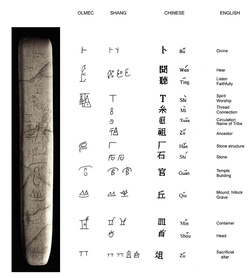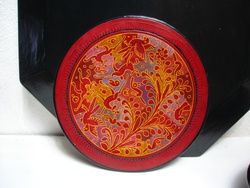>> Read Part 2
Spending a life trying to convince the orthodoxy that one has found differences between accepted doctrine and new realities must be awfully frustrating. Eons often slip by before cultural barnacles can be removed from the theoretical ships of scientific dogma. Dr. Betty Jane Meggers’ epic stands among the best attempts at barnacle removing. Meggers, perhaps the most distinguished Anthropology’s heterodox is now in good company, but that did not happen until years after her tireless work in Ecuador.

Click to enlarge. Courtesy of Dr. Betty J. Meggers, Director, Latin American Anthropology, at Smithsonian Institution.
Doing a little historical digging, we find in the mid thirties, Mexican anthropologist, Eulalia Guzmán who strongly felt that several Mexican cultures, particularly the Otomi,1 which she deeply studied, showed a strong Chinese imprint. The convoluted Mexican politics of her era, which affected education rather badly, dissuaded Ms. Guzmán to launch a personal odyssey to prove her points.
In the 1950s, Mexican ethnographer and artist Miguel Covarrubias rammed the notion that the history of the Mexican Indian had begun just fifteen hundred years before Cortés. In his superb books Mexico South,2 and, particularly The Eagle, the Jaguar and the Serpent,3 Covarrubias propounded a strong Asian presence in the Olmec culture. At that time, Alfred V. Kidder, (1885-1963) then the foremost expert on the Anthropology of the Southwest and Mesoamerica, criticized as cultural claustrophobia his colleagues’ efforts to develop better theories.
Years later (1992), Mexican-born anthropologist Celia Heil,4 after spending long years studying the Purépecha5 culture of Michoacán, in southwestern Mexico, produced an important paper on their exquisite use of metallurgy for artifacts closely resembling those coming from South Asia: jewelry; dotaku-bells for rituals and prayers; tools, etc. She found many other Asian cultural characteristics in the cultures of the Mexican southwest, including early paper making technology.6
In 1995, she followed with a piece on Purépecha lacquer techniques, which she compared with those used by Japan (and China) in their utilitarian and ornamental works. The Purépecha were involved in lacquer work long before the arrival of the Spanish. She cited the 1541 report on the topic by Purépecha elders to the Franciscan missionaries Martín de la Coruña and Gerónimo de Alcala, in La Relación de las Ceremonias y ritos y población y gobierno de los indios de la provincia de Mechuacán.7
Heil observed that the term maque, which identifies the Purépecha lacquer technique, closely resembles the Japanese lacquer process maki-e;8 and that urushi, the general Japanese term for lacquer, and Uruapan, the top center of Purépecha lacquer production, have a similar ring. On a third article,9 Heil describes the similarities between the Japanese sandals waraji and the Mexican huaraches.
Meet next Mexican anthropologist-architect Dr. Jorge Olvera, who discovered the remains of the distinguished Jesuit scientist Father Eusebio Kino. Through persistence and determination, and after long, arduous days in the Sonoran Desert, Olvera and his exploring party found the tomb in a bleak little chapel in Magdalena, Sonora, in the hinterlands of Pimería Alta. Olvera also conducted several important studies of forgotten, yet important churches in Mexico and Spain.
After serving ten years as an anthropologist with the Mixe-Zoque, a native culture in the Mexican southwest, Olvera wrote an 80-page tract in Spanish, under the protracted title: Algunas Semejanzas Léxicas Entre el Mixe Zoque y el Antiguo Japonés; (Some lexical similarities between the Mixe Zoque and the Ancient Japanese) CONACULTA, a cultural agency of the State of Chiapas, Mexico, published the book in 2000. Olvera learned to speak Zoque fluently, and observed how certain Zoque words and grammatical structures resembled old Japanese. He shared his suspicions with his close friend, architect Alberto Arai,10 son of a Japanese Ambassador to Mexico. Arai concurred; and Olvera collected and listed nearly six-hundred vocablos—terms which he offered for further analysis by experts in Ancient and Proto-Japanese.
But something else baffled and fascinated Olvera: Zoque body posture during conversation and social contact; respect for elders, filial piety bordering on Confucian precepts, and the classical bow, all making him feel as if observing ancient Japanese culture.11 Surprisingly too, the Zoque myths about the creation of the world included characters similar to Izanagi, Izanami, and other kami (god).12 They could have been yanked out of the pages of the Kojiki or the Nihongi. One of their legends even resembled the tale of Momotaro.
Multilingual Olvera (Spanish, English, Japanese, and Zoque), either did not have the time, the opportunity or the desire to translate his little opus into English. Since CONACULTA limited the edition to 1,000, it requires a true miracle to get a copy; hence, Olvera’s work has remained obscure and unrecognized, never having been reviewed by his peers.
Of course, the first comment that may rise about Guzman, Covarrubias, Heil, and Olvera is that, since colonial times, Mexicans have been infected, with a strong dose of irreducible Japanophilia. The fondness for Japan, its culture and its people began in the heyday of the Manila Galleon, with the arrival of the first Japanese commercial mission to Mexico in 1610.13 In 1614, Sendai’s Date Masamune sent Tsunenaga Rokuemon Hasekura as his Ambassador, to initiate direct commerce with Mexico (New Spain). Hasekura brought with him a large retinue.14 Many members of that group decided to remain in Mexico and integrate with her society. In time, many Japanese surnames made it to the roster of ilustres familias Mexicanas—illustrious Mexican families. This mutual admiration rose throughout the years, and remained constant even during the ghastly days of the Pacific War.
However, the findings of archaeologists, anthropologists, ethnographers and linguists transcend mutual fondness.
I offered Olvera’s ideas for consideration to the distinguished scholars—members of the Pre-Modern Japanese Studies—PMJS-Google, an interesting Internet site for transactions about Japanese cultural topics. Unfortunately, the response was less than encouraging. Of the two expert linguists who responded to my enquiry, one discarded Olvera’s choices after a summary analysis of the first ten terms. Another thought that more than Japanese, some of the terms resemble old Chinese, and others look like a distant mixture of modern and old Japanese. But remember, the origin of the Japanese language, particularly during the proto-historic days, remains cryptic… and tantalizing. Thus the grain of salt comes quite handy here.
Let us now turn the lights on the extraordinary work by Dr. Nancy Yew Davis, an Alaskan born anthropologist, laboriously detailed in her intriguing book: The Zuni Enigma – A Native American People’s Possible Japanese Connection.15 In language free from the academic jargon, which makes anthropological literature a hard climb, her book clutches you to the point that you really can’t stop reading it once you’ve started. When an anthropological torpedo threatens to surface, Dr. Davis rescues you from exasperation with a soothing explanation.
Davis circumscribes the alleged contacts between Japanese and Zuni to a Buddhist mission that landed in western America in the Kamakura period.16 To prove her theory, she reviews legends, myths, tradition, behaviors, artifacts, and language. As if that weren’t enough, she analyzes the hard sciences’ successes in proving strongly the contacts’ possibilities… genes, illnesses, parasites, flora, etc. Wisely anticipating where a heckling may come, she minutely dissects—pro and con—every one of her choices, leaving you with the certainty that she has left no shard unturned. By the time you have finished the book, you can only mumble, “Hai! … It went that-a-way.”
A lot of other illustrious scientists have initially entered or joined the diffusionist camp in support of the transpacific contacts’ theses. More on that in our next chapter.
Notes:
1. Otomi, self-identified as Hñähñu, is a tribe in the Central Plateau of Mexico.
2. New York: Alfred A. Knopf; 1946
3. New York: Alfred A. Knopf; 1954
4. Ms. Heil formerly with the National Science Foundation, was also the first Mexican woman to serve in the South Pole as a member of the 1979 US Arctic Research Expedition.
5. The Purépecha are also known as Tarasco—father, or brother in law—the misnomer the Spanish conquerors applied to members of that culture
6. (1992); Across Before Columbus. Edgecomb, ME.
7. (1995); NEARA Journal; Vol. XXX, 1&2; pp. 32/39
8. Maki–e (lit. sprinkled picture) is the Japanese lacquer technique in which the artist sprinkles gold or silver powder on an object, or adorns it with either to enrich the decoration.
9. Japanese and Mexican Sandals. (2004) Pre-Columbiana, Vol 3 #1-3
10. Alberto Arai, became one of the most distinguished Mexican architects. A socialist, he emphasized the use of indigenous materials for habitat in the tropical regions. His most famous work is the Frontones—handball courts—at the National University of Mexico, UNAM, using lava to create truncated pyramids.
11.The Zoque sit in the characteristic pose of the Japanese, with the buttocks on the feet and a straight spine. Their bows to show respect resemble those of an old samurai to his lord.
12. Kami—sacred powers of the Shinto faith.
13. Merchant Tanaka Shosuke and his 22 companions are assumed to be, historically, the first Japanese to have crossed the Pacific into America.
14. Sixty samurai and 130 traders.
15. (2000); New York: W.W. Norton.
16. Around 1250 AD.
© 2010 Edward Moreno






